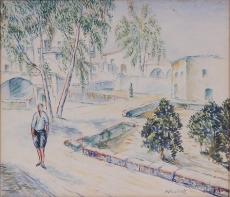


Nicos Nicolaidis, one of the most important writers not only of Cyprus but of greater Hellenism, became acquainted with painting at a very early age. Orphaned when he was six or seven years old, he was forced to leave school in the fourth grade and begin to eke out a living. He was taught the art of icon painting and began to tour the countryside, undertaking to paint Byzantine icons.
At the age of 23, Nicolaidis went to Athens, where he audited courses at the School of Fine Arts for a period of about six months. In 1909 he travelled to Italy, where he was introduced to the Italian Renaissance, and to other European countries, where he studied art in museums, galleries and libraries. He also toured countries of the Near and Middle East. From 1919 to 1923, he lived in Cyprus, teaching art at a private secondary school in Limassol. At the same time, he became very active as an artist. In 1919 he organised a solo exhibition of his work, one of the first exhibitions on the island. In 1923 Nicolaidis settled permanently in Egypt, but maintained very close ties with Cyprus until the end of his life.
It is assumed that the artwork, Road in Old Nicosia, was painted between 1919 and 1923, the period during which the artist lived in Cyprus. It depicts a view of the old city of Nicosia, which Nicolaidis knew very well since, at a very tender age, after losing both his parents, he had lived in his aunt’s house in the heart of the city, within the Venetian walls. This is an early work, which goes no further than the descriptive depiction of the subject matter. In this landscape painting of built space, the painter faithfully rendered the city’s distinctive, traditional architecture. To lend vitality and vigour to his subject matter, he placed a young man in the foreground, dressed in short black breeches and a white shirt, walking blithely along the road. In this watercolour, the dominant colour is white, upon which the landscape is developed with quiet brushstrokes of blue, green and orange hues. The harmonious arrangement of the painting’s components evokes the atmosphere of a quiet Nicosian neighbourhood with its unpaved roads and whitewashed walls.
Painting from nature held a dominant position in Nicolaidis’ art until the end of his life. His efforts to describe, to see, to penetrate his subject, to discover every last detail, in order to then be able to delve deeper and proceed from the exterior to the interior, was a process which he also observed in his literary work. In his painting, this tendency is more apparent in works he presented in 1929 in his only two solo exhibitions, in Alexandria and Cairo. Indicative of his effort was an interview he gave in 1939. Speaking of his sojourn in Italy, he noted: ‘I worked a lot. Above all I walked. And I saw. Do you know what it means “to see”? I paint and I draw from nature. Nobody can “see” if they don’t paint
and write.’1
Notes:
1Ελευθερία, op. cit
He apprenticed for a short time under an icon painter and audited painting classes for a few months at the School of Arts (later known as the School of Fine Arts) in Athens. In 1923 he settled in Egypt, but maintained close ties with Cyprus until the end of his life. In parallel to his prolific literary output, he applied himself systematically to painting and icon painting. He produced a large number of drawings in ink and pastel, as well as watercolours and oils. He drew inspiration from the landscape and the people, especially those of Egypt. The academic and meticulous treatment seen in his early works was replaced by a plein air style of painting when he began to paint from nature. His personal style was crystallised in his landscapes of Egypt and Sinai, to which he managed to lend space a transcendental, ethereal dimension. He showed his work in solo exhibitions in Cyprus (1919), Cairo (1929) and Alexandria (1929).